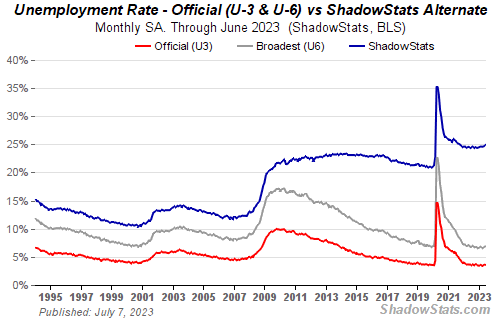Last year I posted a blog entry about how the U.S. government grossly understates how bad of shape the U.S. economy really is. With U.S. politicians like Barack Obama and Vice President Joe Biden proclaiming that the U.S. is experiencing “recovery summer” I thought it would be a good idea to review what the economic situation is really like in the U.S.. Most people do not believe what politicians have to say, but it’s good to have an idea of how much discrepancy there is between what politicians portray and what reality actually is.
Last week the U.S. government claimed that the unemployment rate fell from 9.7% to 9.5%. This 9.5% rate does not take into account a very important group of people: those who have given up looking for work because they cannot find a job. Growth in this unaccounted category of people had a major impact on the unemployment rate reported by the U.S. government as an estimated 652,000 Americans gave up looking for work in the month of June.
Economist John Williams, who specializes in exposing how manipulated U.S. economic data is, estimates that the true unemployment rate is closer to 21.6% (SGS Alternative) which would put the U.S. at par with Spain, a country that is in serious trouble. The following chart illustrates how understated the U.S.’s unemployment problem is:
The U.S. government is also guilty of understating the rise in consumer prices. The reason the U.S. government has incentive to understate the rise in consumer prices is so they can limit the cost of living pay increases (COLAs) that they give to certain Americans each year. The following chart shows that there is a major discrepancy between what the U.S. government reports and what Williams’ reports (which is the way the U.S. government used to measure the change in consumer prices before the Clinton Administration changed it).
As a consequence of understating the rise in consumer prices, the U.S. government ends up always overstating the level of economic growth (Change in Real GDP = Change in Nominal GDP divided by Change in Prices). Williams’ work indicates that GDP, the main measure of economic growth, may be significantly overstated.
If Williams’ numbers are truly accurate then the idea of there being a “jobless recovery” in the U.S. is a myth since there is not a recovery (we have negative changes in GDP). The chart above suggests that the U.S. economy is still in recession albeit the rate of decline was slowing up until now.
Overall, the U.S. economy is not nearly as strong as American politicians claim or the media portrays it to be. There may, in fact, be a huge discrepancy between myth and reality, a discrepancy so large that the idea that the U.S. is experiencing a jobless recovery may be a complete myth.
I suspect that the U.S. government may eventually report that the U.S. economy is in recession again as U.S. economy weakens. The issue though is that when the U.S. government reports that the economy is experiencing a recession the reality may be that the U.S. economy is experiencing a depression.




